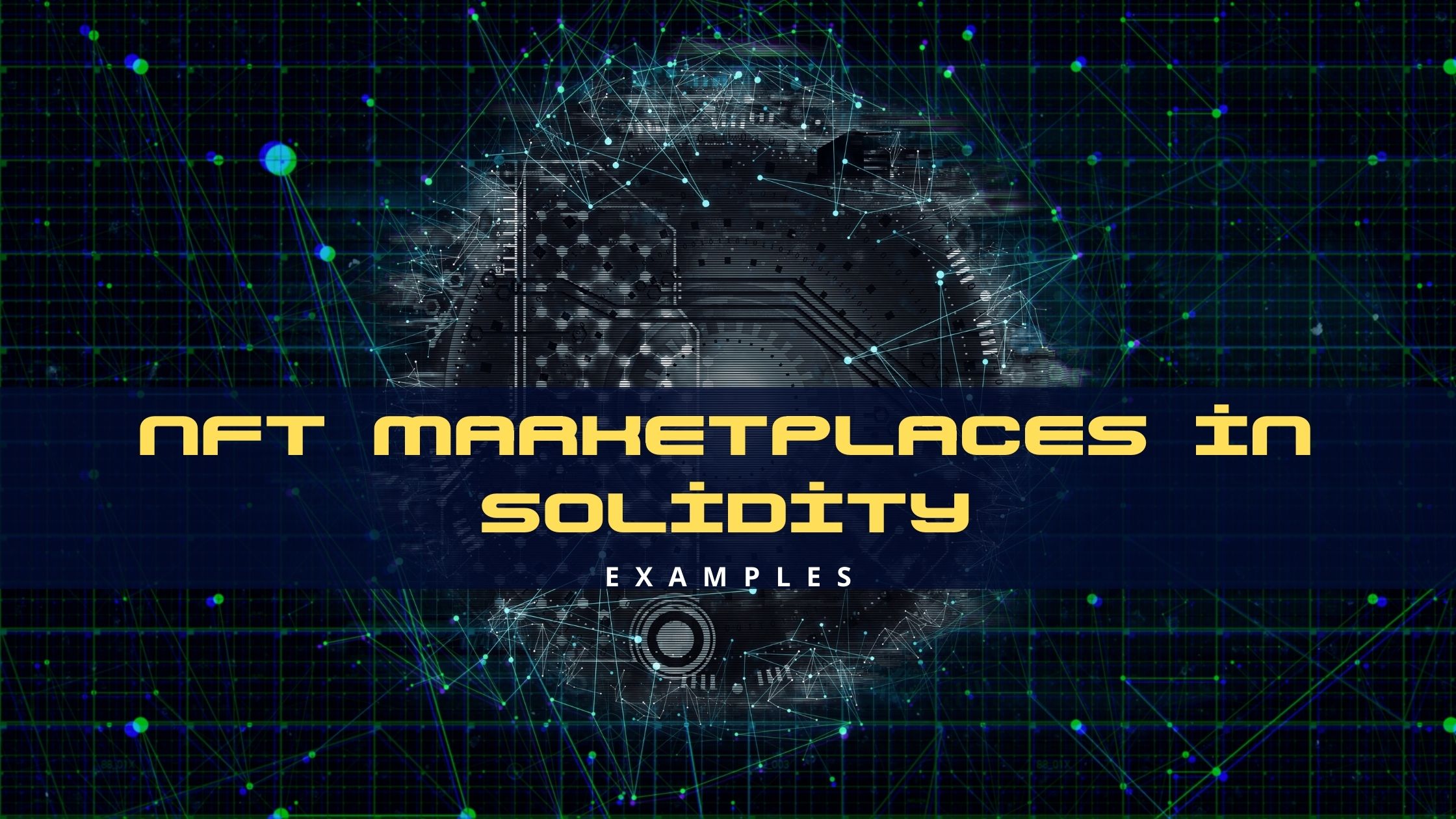The “backend” of an NFT Marketplace built using Solidity, plays an important role in holding inventory and connecting buyers and sellers. NFTs are digital assets that represent real-world objects such as a piece of art, music, game items, videos, and even tweets. They are unique cryptographic tokens that cannot be replicated and exist on a blockchain.
The first NFT emerged in 2014 and since then has been growing exponentially. It has become so popular that it is estimated the NFT market size surpassed $41 billion in 2021. In a span of a few years, NFT has reached heights no one could have imagined.
The pandemic that hit the world helped further to increase the popularity of NFTs. This trend can be observed since the trading volumes of NFTs rose by 704% between the second quarter of 2021 to the third quarter of 2021 which is an eightfold gain in volumes.
NFT Marketplace
To become a part of this NFT craze, the NFT marketplace is the getaway to participating in the sale and purchase of these digital assets. These digital assets can range from art to music to entire virtual worlds. You can imagine NFT marketplaces like the Amazon of the digital realm.
There are many NFT marketplaces present. Out of them, Opensea is by far the most popular and the largest NFT marketplace currently. It is estimated that each month 250,000 people trade NFTs on the OpenSea marketplace. It is the original peer-to-peer alternative that enables users to buy and sell non-fungible tokens online.
They are therefore like the hubs where the world’s highly valuable assets are traded. There are currently dozens of NFT marketplace and thus it becomes important for users to select the correct NFT marketplace to trade their NFTs. The NFT marketplace can be chosen by considering the type of tokens that are supported on the marketplace.
NFT Smart Contracts
NFTs are minted using smart contracts that assign ownership of the NFTs and manage their transferability. When users create or mint an NFT, they execute the code that is stored in the form of smart contracts. The codes in the smart contracts conform to different standards like ERC-721.
NFT marketplace in Solidity
The implementation of NFT marketplaces is not very difficult. Once the marketplace is implemented successfully, users can create, buy, and sell their own NFTs. A simple technology stack based on Solidity, Truffle, JavaScript, and other technologies can be used to create the front-end of the NFT marketplace. These technologies are primarily required for the development of the NFT marketplace.
Solidity is an object-oriented high-level programming language used for developing and implementing smart contracts. Since we know smart contract forms the basis of any NFT and its transaction, Solidity is the core language required for the implementation of NFT marketplaces.
Examples of NFT marketplaces in Solidity
1] Crypto Boy NFT Marketplace – It is an NFT marketplace where you can mint Crypto Boy NFTs implemented by ERC 721 and manage them on Ethereum Blockchain.
The NFT marketplace has many features such as –
- It enables users to mint custom ERC721 implemented Crypto Boy tokens.
- It sets desired token price and sells these Crypto Boy tokens on the marketplace.
- It can toggle between the choices to keep the token either on sale or not for sale.
- It keeps track of all the tokens that are owned by an account whether they are minted or bought.
- It can query the blockchain for token-related information like the token owner and token metadata.
- It allows a user to mint a token only every 5 minutes.
2] MiquellTC – It is an open decentralized NFT marketplace. It is built with smart contracts powered by Ethereum in Solidity. It consists of an open platform where users can min their NFTs and offer them on a marketplace for selling or buying NFTs from others.
The miquelITC project consists of the following –
Features –
The user can perform the following actions on this miquelITC NFT marketplace –
- Mint – A creator can mint his NFT by inputting the name, and description and uploading the file (image). This minted NFT’s representation will be displayed in the marketplace and will be initially owned by its creator. Since this NFT is open to everyone, anyone can participate in the NFT creation within this collection.
- Make and cancel offer – The user can an offer for his NFT by specifying its price in Ether and once someone fulfils this offer the ownership can be transferred to the new user. The user can also choose to cancel his NFT if he does not want to sell the NFT anymore or if he wishes to change the price.
- Buy – A user can buy NFT offered by someone else
3] BravoNatalie – It is an NFT Marketplace where it allows the transaction of buying and selling of digital arts as NFTs. It is a marketplace that enables the creation, sale, and purchase of digital art as NFTs.
The architecture and client flow for the projects follows the following steps –
- The user opens the website
- The platform requires the user to have a valid wallet
- The users with a valid wallet can create and configure an NFT on the website
- Once the NFT is created it is listed on the platform
- If this NFT is for sale, a buyer can make an offer to buy the NFT
- Once the sale is made the platform handles the transfer of funds, ownership, and removal of the NFT from the list for sale.
The project is still under construction with the following things pending –
- State persistence
- Error handling
- Revise the front-end buy and sell functions on the blockchain
- NFT cards that reflect the true information about the price coming from the blockchain for the NFTs
4] AWS-samples – This project provides users with sample codes to build a simple NFT marketplace with Amazon Managed Blockchain. Each token in NFT is unique and thus can create a relationship or contract between a specific unique token and a specific asset that can be a physical or a virtual asset or much more. This contract helps prove the ownership of a digital asset.
There are multiple standards for NFTs but for this exercise, the Ethereum Blockchain network and the ERC-721 standard will be used for NFTs.
The following way new contracts can be created –
- A node is created which is connected to a Blockchain network
- A contract is manually generated, verified, and deployed
- To automate the process, an API is deployed
- A Front End is created that utilizes the API
- The Marketplace Front End is finally deployed
5] Silviopaganini – It is a prototype of an NFT marketplace that is based on OpenZeppelin abstract upgradable ERC-721 contracts. It is also minting/uploading images of IPFS and integration with Opensea.io. This project relies on the NFT Lambda service for serving the metadata and on the NFT contracts package.
Functionalities of the project –
- Users can buy pre-minted tokens
- Users can easily sell the token that has been bought by them
- Users can transfer the Ether to the previous token holder with ease
- Users can add and remove tokens from the marketplace at their convenience
- Users can mint their tokens
- Users can upload NFT images to IPFS
- Metadata and Marketplace are available on opensea.io
- Metadata and IPFS Lambda functions are available on AWS
6] Thales BMCmake – A NFT marketplace that allows users to mint, sell, and buy NFTs and is made with Next.js, Tailwind, Polygon, and Firebase. Metamask extension can be added to be able to add a wallet. This will allow the users to easily undertake transactions on the NFT marketplace.
7] Sumit03guha – It is a repository that is comprised of very basic smart contract implementation of minting and trading of NFT assets.
8] Dabit3 – It builds a Full Stack Marketplace on Ethereum with technologies such as React, Solidity, Hardhat, and Ethers.js.
The marketplace comprises of two smart contracts –
- NFT smart contract for minting NFTs
- Marketplace smart contract for facilitating the sale of NFTs
Users can use the ERC-721 standard available on OpenZeppelin for writing an NFT.
Once the project is complete users will be able to create, view, and purchase NFTs from the marketplace.
Conclusion
The growth of the NFT market is the new trend as its market value is growing rapidly. As the value of NFTs rises, the appealing characteristics of the NFT market network are attracting more and more users with time.
The blockchain platforms have been showing high trend graphs which is making them more attractive to investors and they are increasingly adopting them. The NFT marketplace thus shows a potential for a promising future. Thus, it has become increasingly important for users to get their NFT platforms up and running so that they don’t miss out on trading NFTs and lose out on opportunities to earn out of them.


